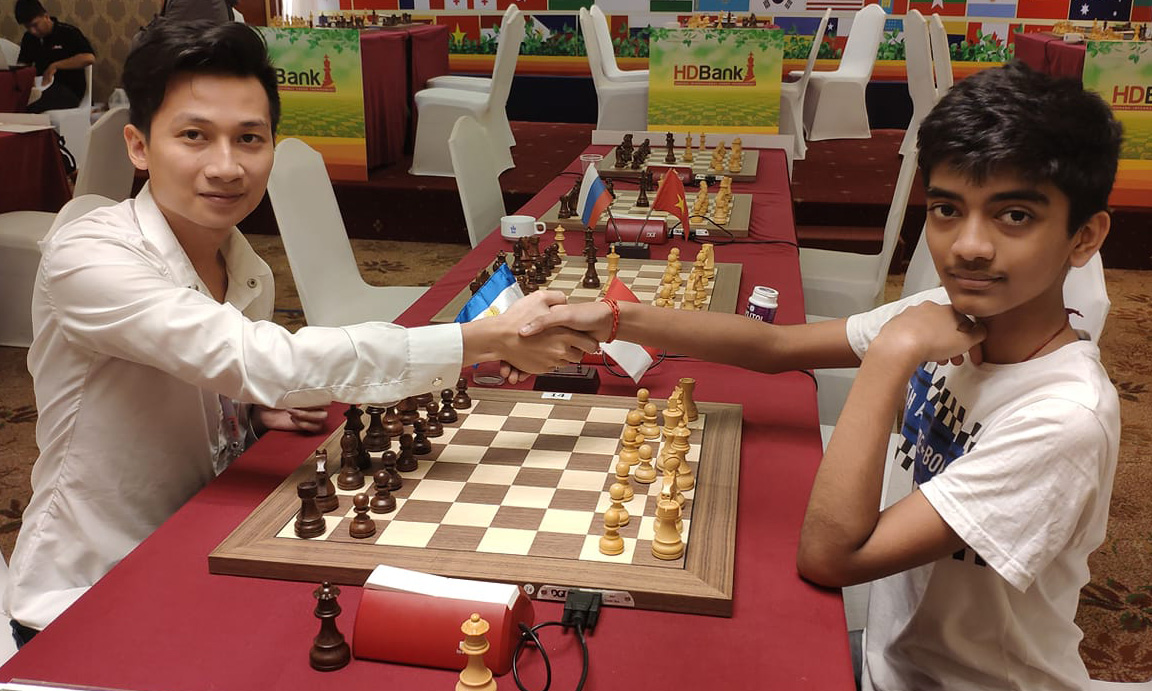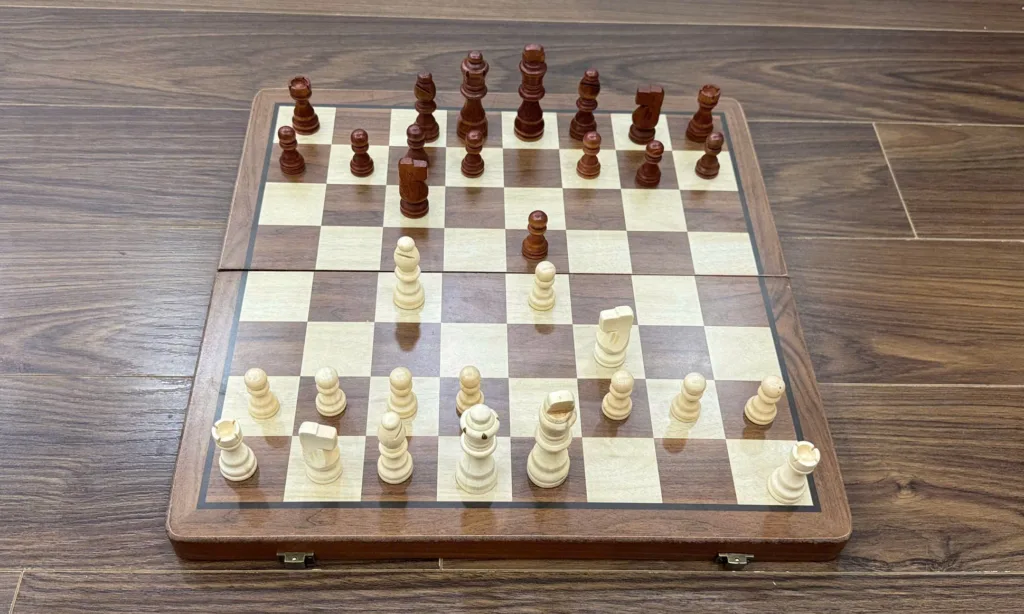Unpack the Giuoco Piano (Italian Opening), Two Knights’ Defense, and Scotch Game – classic 1.e4 e5 battles full of traps, tension, and tactical fireworks.
Giuoco Piano Opening begins:
- e4 e5
- Nf3 Nc6
- Bc4 Bc5
It Looks Peaceful… But Don’t Be Fooled
This opening is named the Giuoco Piano, which literally means “quiet game.” But beneath the calm, it hides sharp ideas, traps, and sudden turns.
White’s got options here, and they all shape the game differently:
Option A: Giuoco Pianissimo (“The Quietest Game”)
White plays d3 and Nc3.
This setup keeps the center locked and can become very positional. The game is often slow and maneuvering, unless Black gets careless and castles too soon after Bg5, allowing White to strike.
White is keeping everything under control. The goal is to avoid early exchanges and provoke weaknesses. Nc3 supports the e4 pawn and controls d5. d3 keeps the center flexible, waiting for the right moment to strike. White often maneuvers slowly with 0-0, Re1, h3, and Be3 before deciding whether to play d4 or f4.
Option B: Modern Closed System
White plays d3 and c3, preparing d4 later.
It echoes the structure of the Ruy Lopez, slow buildup, central tension, and a focus on maneuvering over tactics. White wants to quietly prepare a central break later. c3 covers d4 and supports the typical pawn thrust. With d3, the e4 pawn is defended, but White doesn’t commit to the center immediately. It’s about patience, inviting Black to overextend or misplace a piece before exploding with d4.
This game between Magnus Carlsen (White) and Vidit Gujrathi (Black) from the Skilling Open 2020 is a dramatic example of how even top-level Italian Opening games can swing wildly based on small inaccuracies and missed opportunities:
Option C: Classical Giuoco Piano
White goes for c3 and d4, launching a direct attack on the center. This line can lead to rich open positions.
This is for players who want to fight for the center early. The plan is to build up quickly and open lines for both Bishops. If Black isn’t ready, the center can collapse fast. But it’s double-edged: if White overreaches or plays d4 too early, Black can counter with d5 or f5, or attack the e4 pawn.
- If Black knows the theory, he equalizes easily.
- If Black slips, he could be knocked out in ten moves.
Option D: Evans Gambit
White plays b4, sacrificing a pawn to get c3 and d4 in with blazing speed.
This is no longer a “quiet game.” It’s the Giuoco Piano on espresso. Highly aggressive, best suited for players who want to seize the initiative early, even at material cost.
The b4 push is pure ambition. White sacrifices a pawn to pull Black’s Bishop off the a7-g1 diagonal, gaining time to slam c3 and d4. The resulting lead in development often overwhelms unprepared opponents.
Read More: Evans Gambit: The Opening that Gives a 60% Chance to Win
The Two Knights’ Defence: The Calm Is Over
1. e4 e5
2. Nf3 Nc6
3. Bc4 Nf6
This looks like it might transpose back to the Giuoco… but it doesn’t.
Welcome to the Two Knights’ Defence, a more tactical beast altogether.
White’s Choices:
a) Nc3
Looks natural, but it’s actually a bit toothless. Nc3 develops a piece but doesn’t confront Black’s real idea, the e4 pawn. After Nxe4 and d5, Black gets central control and tempo. White looks solid but is already on the defensive.
b) d3, then c3 or Nc3
A closed game. More strategic, less fun for attackers. This is the “Italian-style” way of neutralizing the Two Knights. d3 protects e4. Then c3 or Nc3 reinforce central tension. It’s a good line for players who want structure over tactics, but it gives Black time to complete development easily.
c) Ng5 – the Fried Liver Attempt
This is the most tempting line for juniors, tacticians, and YouTubers. White eyes f7 and tries to sack-and-attack. Because f7 is the weakest square in Black’s position. Ng5 threatens Nxf7, which can fork the Queen and Rook after e.g. Bc4-f7+ and Nxf7. It aimed at catching Black off guard. If Black doesn’t know the theory, they could be dead in 10 moves.
It goes:
4. Ng5 d5
5. exd5
Now Black has a fork in the road:
- Na5 – counterattacks the Bishop
- b5 – a rare but aggressive counter
- Nd4 – central firepower
- Nxd5 – tempting, but bad. White wins big if Black takes the pawn here.
d) d4 – immediate central tension
This is sharp and aggressive. White challenges the center before Black has castled. Black should respond carefully.
Correct move: exd4
Terrible move: Nxe4, walking straight into traps. Check out the game below to see how an International Master fell for this trap.
The Scotch Game: No Nonsense, Just Fight
1. e4 e5
2. Nf3 Nc6
3. d4
Boom. The gloves come off.
White doesn’t dance around here. The Scotch goes for the throat, striking the center immediately.
3… exd4
The only correct reply. Any delay, like 3… d6 – lets White grab the advantage with dxe5.
4. Nxd4
The classic continuation. But White could detour:
- 4.c3 – the Göring Gambit, sacrificing a pawn for speed.
- 4.Bc4 – the Scotch Gambit, inviting tactical fireworks.
What Should Black Do Now?
4… Nxd4 is a common trap. White plays Qxd4, and suddenly the Queen is ideally placed. Black’s under pressure for the rest of the game.
More promising for Black:
- Qh4 – aggressive, looking to cause chaos. White must reply carefully (best is Ndb5).
- Nf6 – attacking e4 and speeding development.
- Bc5 – pressuring the Knight and preparing for kingside castling.
Final Thought
- The Giuoco Piano might look calm, but one wrong move and it’s a tactical minefield.
- The Two Knights’ line is not for the faint of heart, especially if you go Ng5.
- The Scotch is for players who want clarity, activity, and immediate action.
So whether you want to ease in with a soft Italian sonata or launch a full-on symphony of destruction… there’s a flavor here for every chess player.

I’m Xuan Binh, the founder of Attacking Chess, and the Deputy Head of Communications at the Vietnam Chess Federation (VCF). My chess.com and lichess rating is above 2300. Send me a challenge or message via Lichess. Follow me on Twitter (X) or Facebook.


1 thought on “Why the Giuoco Piano Still Catches Players Off Guard”
Comments are closed.